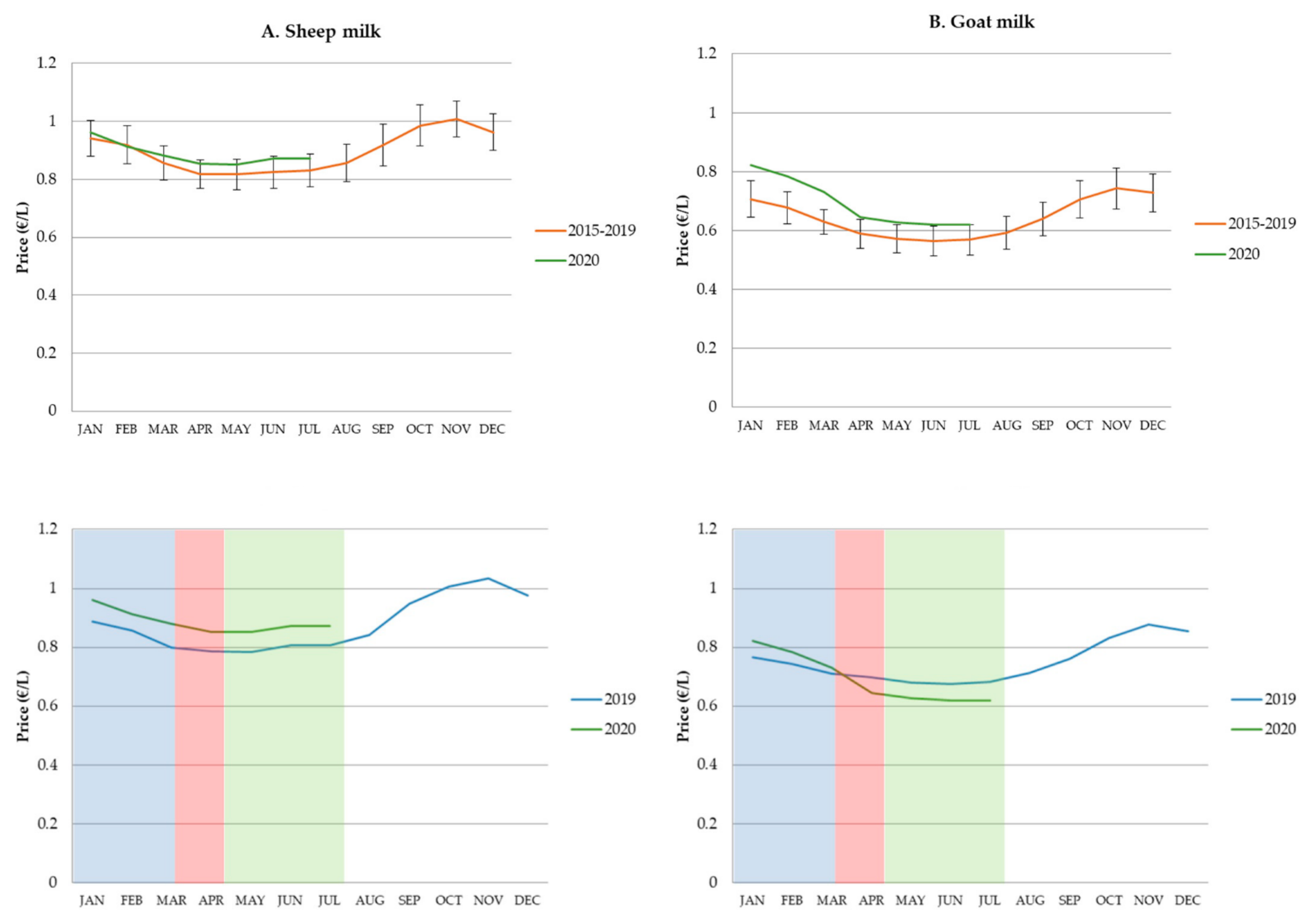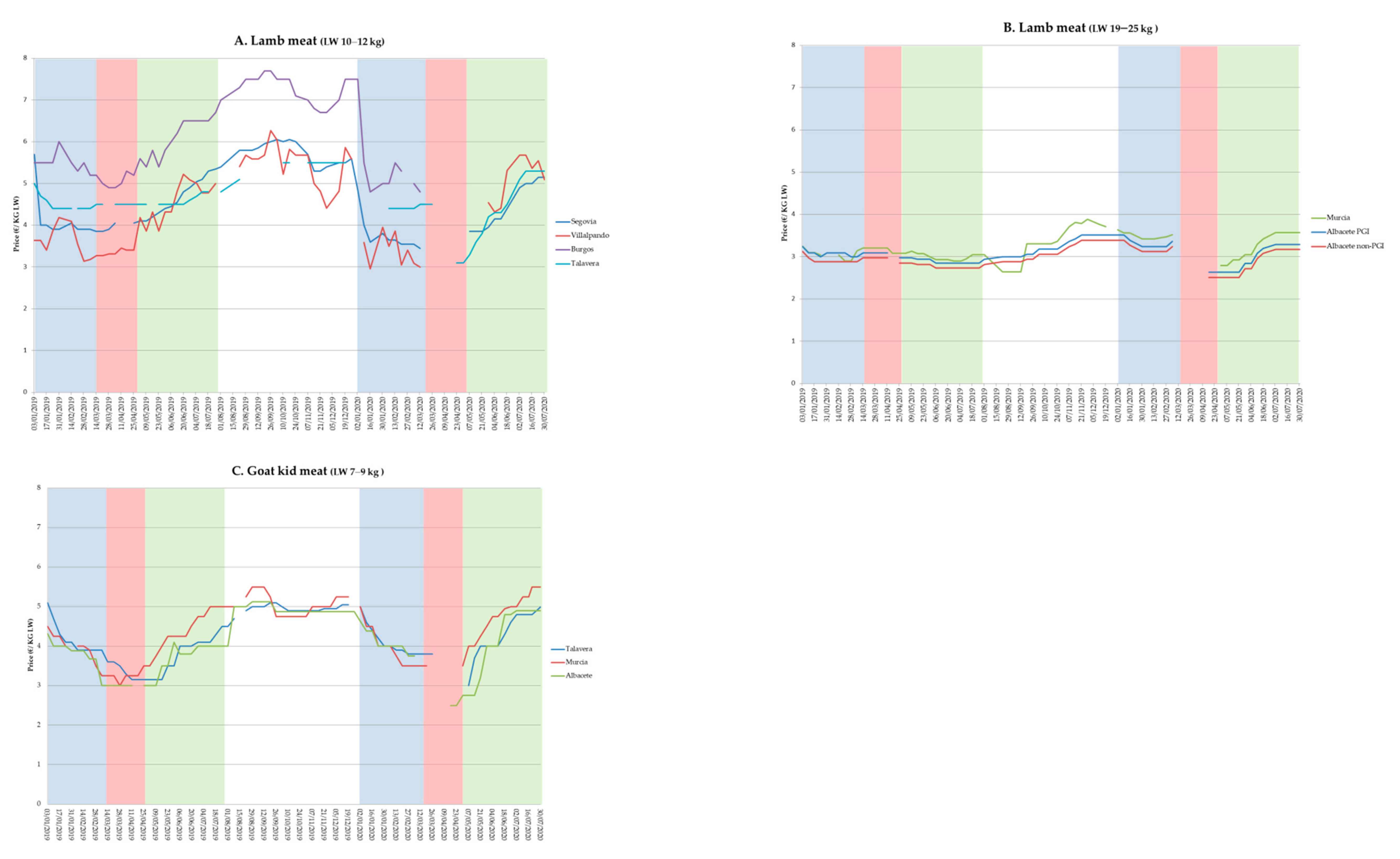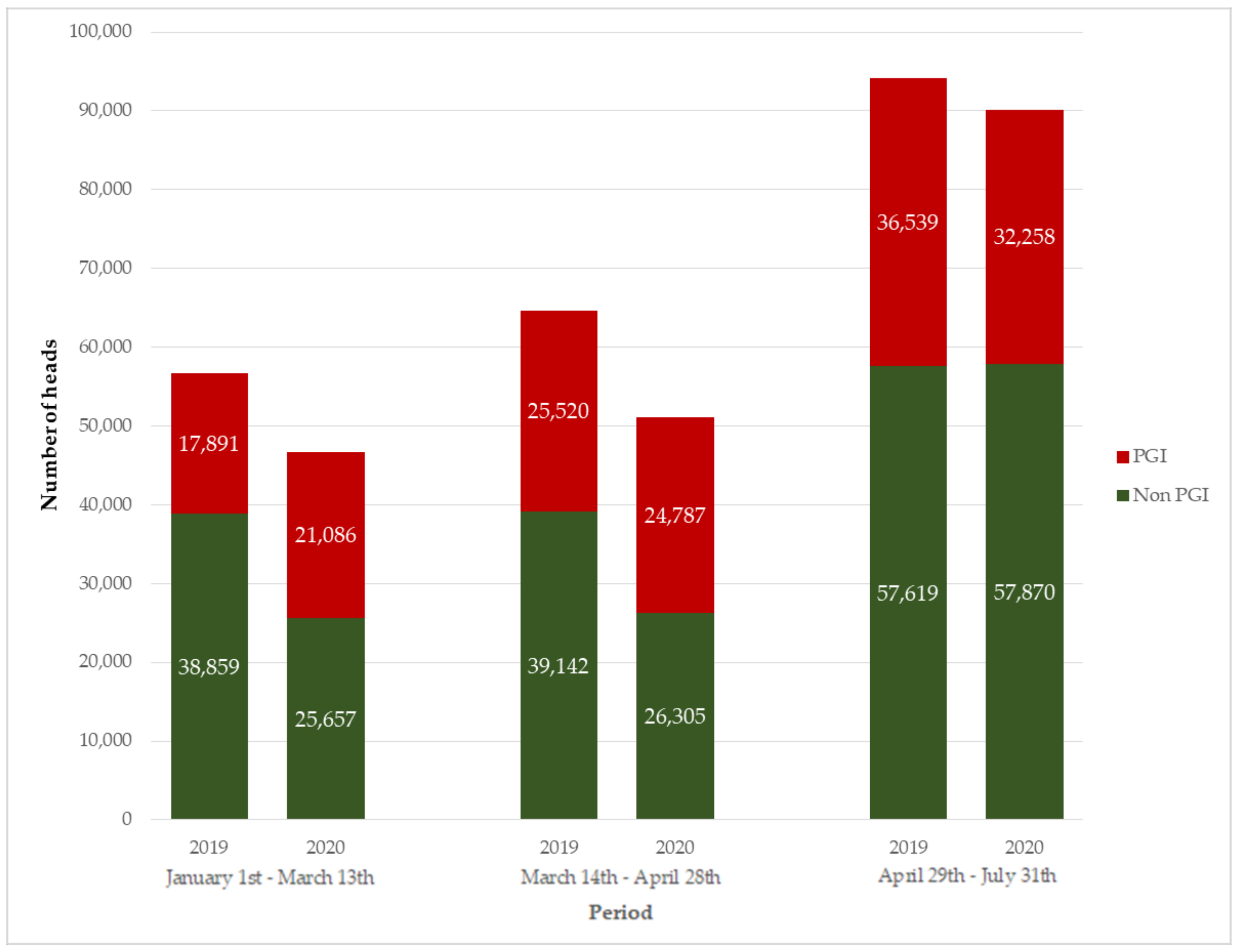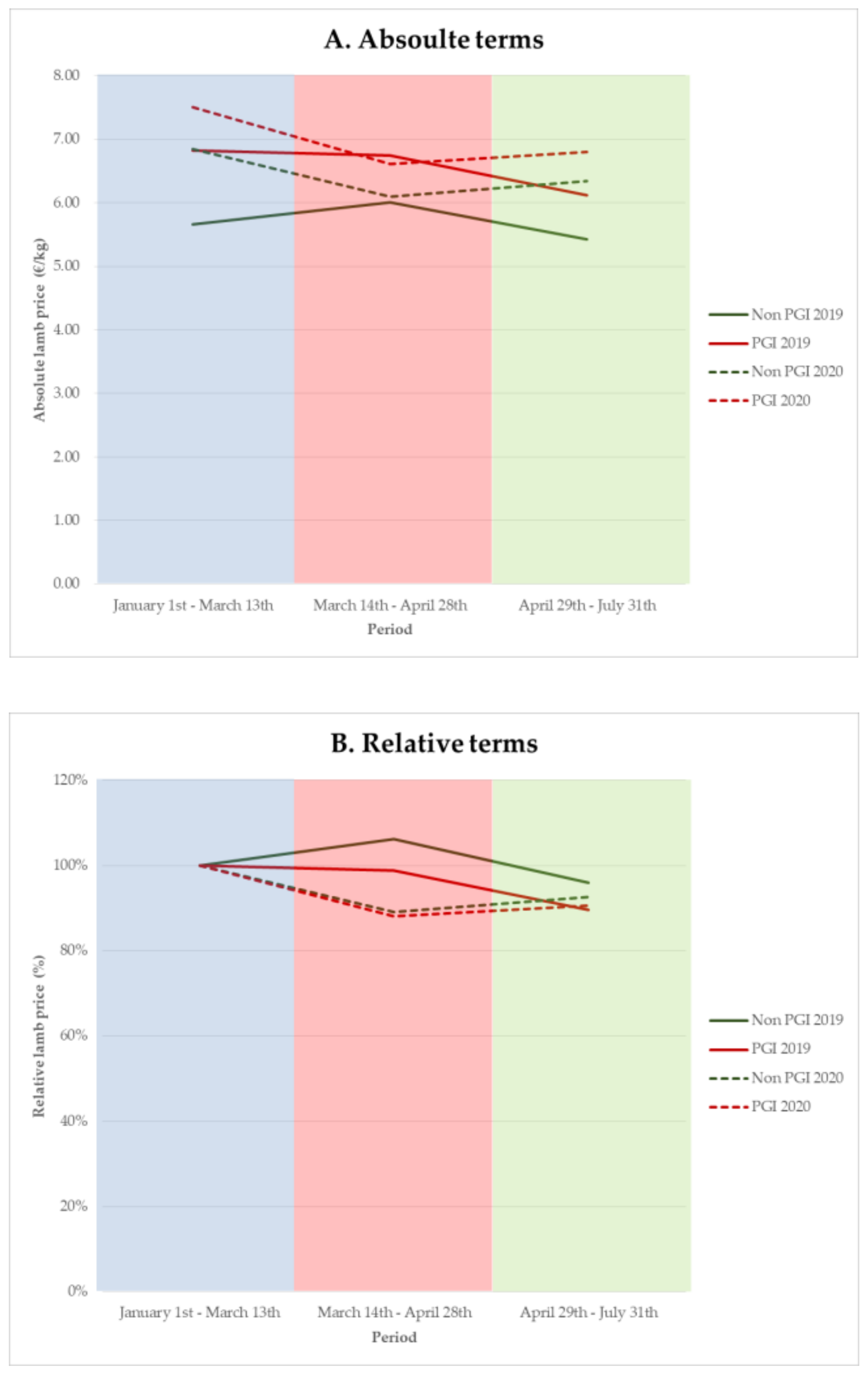Price Fluctuation, Protected Geographical Indications and Employment in the Spanish Small Ruminant Sector during the COVID-19 Crisis
Abstract
Simple Summary
Abstract
1. Introduction
2. Materials and Methods
2.1. Design
2.2. Milk Prices Published by InLAC
2.3. Evolution of Meat Prices on Agrarian Markets
2.4. Influence of PGI on Lamb Sale and Price Fluctuation
2.5. Evolution of Employment on Flocks
2.6. Statistical Analysis
3. Results
3.1. Analysis of Spanish Small Ruminant Milk Prices from 2015 to 2020
3.2. Analysis of Meat Prices Provided by Agrarian Markets
3.3. Differences in Sales and Prices among PGI and Non-PGI Lambs
3.4. Analysis of Employment on Flocks
4. Discussion
5. Conclusions
Author Contributions
Funding
Acknowledgments
Conflicts of Interest
References
- Lai, C.C.; Liu, Y.H.; Wang, C.Y.; Wang, Y.H.; Hsueh, S.C.; Yen, M.Y.; Ko, W.C.; Hsueh, P.R. Asymptomatic carrier state, acute respiratory disease, and pneumonia due to severe acute respiratory syndrome coronavirus 2 (SARS-CoV-2): Facts and myths. J. Microbiol. Immunol. Infect. 2020, 53, 404–412. [Google Scholar] [CrossRef] [PubMed]
- Lai, C.C.; Shih, T.P.; Ko, W.C.; Tang, H.J.; Hsueh, P.R. Severe acute respiratory syndrome coronavirus 2 (SARS-CoV-2) and coronavirus disease-2019 (COVID-19): The epidemic and the challenges. Int. J. Antimicrob. Agents 2020, 55, 105924. [Google Scholar] [CrossRef] [PubMed]
- Ge, H.; Wang, X.; Yuan, X.; Xiao, G.; Wang, C.; Deng, T.; Yuan, Q.; Xiao, X. The epidemiology and clinical information about COVID-19. Eur. J. Clin. Microbiol. Infect. Dis. 2020, 39, 1011–1019. [Google Scholar] [CrossRef] [PubMed]
- Johns Hopkins University and Medicine. Coronavirus Resource Center. Available online: https://coronavirus.jhu.edu (accessed on 15 September 2020).
- Centro Nacional de Epidemiología (CNE). COVID-19 en España. Available online: https://cnecovid.isciii.es (accessed on 22 September 2020).
- Petrosillo, N.; Viceconte, G.; Ergonul, O.; Ippolito, G.; Petersen, E. COVID-19, SARS and MERS: Are they closely related? Clin. Microbiol. Infect. 2020, 26, 729–734. [Google Scholar] [CrossRef] [PubMed]
- European Commission. Travel During the Coronavirus Pandemic. Available online: https://ec.europa.eu/info/live-work-travel-eu/health/coronavirus-response/travel-during-coronavirus-pandemic_en (accessed on 22 September 2020).
- Napierała, T.; Leśniewska-Napierała, K.; Burski, R. Impact of geographic distribution of COVID-19 cases on hotels’ performances: Case of Polish cities. Sustainability 2020, 12, 4697. [Google Scholar] [CrossRef]
- Nurchis, M.C.; Pascucci, D.; Sapienza, M.; Villani, L.; D’Ambrosio, F.; Castrini, F.; Specchia, M.L.; Laurenti, P.; Damiani, G. Impact of the burden of COVID-19 in Italy: Results of disability-adjusted life years (DALYs) and productivity loss. Int. J. Environ. Res. Public Health 2020, 17, 4233. [Google Scholar] [CrossRef] [PubMed]
- Adney, D.R.; Brown, V.R.; Porter, S.M.; Bielefeldt-Ohmann, H.; Hartwig, A.E.; Bowen, R.A. Inoculation of goats, sheep, and horses with MERS-CoV does not result in productive viral shedding. Viruses 2018, 8, 230. [Google Scholar] [CrossRef] [PubMed]
- Li, Y.; Wang, H.; Tang, X.; Fang, S.; Ma, D.; Du, C.; Wang, Y.; Pan, H.; Yao, W.; Zhang, R.; et al. SARS-CoV-2 and three related coronaviruses utilize multiple ACE2 orthologs and are potently blocked by an improved ACE2-Ig. J. Virol. 2020, 94, e01283-20. [Google Scholar] [CrossRef] [PubMed]
- Vidaurreta, I.; de la Fe, C.; Orengo, J.; Gómez-Martín, Á.; Benito, B. Short-term economic impact of COVID-19 on Spanish small ruminant flocks. Animals 2020, 10, 1357. [Google Scholar] [CrossRef] [PubMed]
- Gilbert, C.L.; Morgan, C.W. Food price volatility. Philos. Trans. R. Soc. B 2010, 365, 3023–3034. [Google Scholar] [CrossRef] [PubMed]
- European Parliament Research Service. Price Volatility in Agricultural Markets: Risk Management and Other Tools. Available online: http://www.fao.org/3/am053e/am053e00.pdf (accessed on 7 November 2020).
- European Commission. Quality labels. Quality Schemes Explained. Available online: https://ec.europa.eu/info/food-farming-fisheries/food-safety-and-quality/certification/quality-labels/quality-schemes-explained#relatedlinks (accessed on 20 August 2020).
- Loureiro, M.L.; McCluskey, J.J. Assessing consumer response to protected geographical identification labeling. Agribussiness 2000, 16, 309–320. [Google Scholar] [CrossRef]
- Ferrer-Pérez, H.; Abdelradi, F.; Gil, J.M. Geographical indications and price volatility dynamics of lamb prices in Spain. Sustainability 2020, 12, 3048. [Google Scholar] [CrossRef]
- European Commission. Agricultural Markets and Prices. Available online: https://ec.europa.eu/info/food-farming-fisheries/trade/agriculture-markets-and-prices_en (accessed on 18 September 2020).
- Labour Force Survey, Spanish Statistic Institute (INE). Available online: https://www.ine.es/dyngs/INEbase/en/categoria.htm?c=Estadistica_P&cid=1254735976595. (accessed on 25 September 2020).
- Ministerio de Agricultura, Pesca y Alimentación. Necesidades Formativas de la Juventud Rural. Available online: https://www.mapa.gob.es/es/desarrollo-rural/publicaciones/publicaciones-de-desarrollo-rural/estudiodenecesidadesformativasdejovenes_tcm30-537805.pdf (accessed on 7 November 2020).
- Boletín Oficial del Estado (BOE) Núm. 67, de 14/03/2020. Real Decreto 463/2020, de 14 de Marzo, por el que se Declara el Estado de Alarma para la Gestión de la Situación de Crisis Sanitaria Ocasionada por el COVID-19. (In Spanish). Available online: https://www.boe.es/eli/es/rd/2020/03/14/463/con (accessed on 1 November 2020).
- Boletín Oficial del Estado (BOE) Núm. 123, de 3/05/20. Orden SND/387/2020, de 3 de Mayo, por la que se Regula el Proceso de Co-Gobernanza con las Comunidades Autónomas y Ciudades de Ceuta y Melilla para la Transición a una Nueva Normalidad. (In Spanish). Available online: https://www.boe.es/eli/es/o/2020/05/03/snd387/con (accessed on 1 November 2020).
- Boletín Oficial del Estado (BOE) Núm. 311, de 26/12/2018. Orden APA/1397/2018, de 14 de Diciembre, por la que se Extiende el Acuerdo de la Organización Interprofesional Láctea, al Conjunto del Sector y se Fija la Aportación Económica Obligatoria, para Realizar Actividades de Comunicación y Promoción de la Leche y los Productos lácteos, Fomentar la Transparencia en la Cadena láctea, Contribuir a la Vertebración Sectorial e Impulsar la Investigación, el Desarrollo y la Innovación Tecnológica en el Sector Lácteo, Durante un Período de Cuatro Años. (In Spanish). Available online: https://www.boe.es/boe/dias/2018/12/26/pdfs/BOE-A-2018-17747.pdf (accessed on 1 November 2020).
- Informe Sobre las Lonjas de Productos Agropecuarios. Available online: https://www.mapa.gob.es/es/alimentacion/servicios/observatorio-de-precios-de-los-alimentos/informelonjasagropecuarias-v1-181113_tcm30-128589.pdf (accessed on 5 September 2020).
- Ministerio de Agricultura, Pesca y Alimentación. Encuestas de Sacrificio de Ganado. Available online: https://www.mapa.gob.es/es/estadistica/temas/estadisticas-agrarias/ganaderia/encuestas-sacrificio-ganado/ (accessed on 7 September 2020).
- PGI “Cordero de Extremadura”. Available online: http://www.corderex.com/en/que-es-corderex.php (accessed on 8 November 2020).
- PGI “Cordero Segureño”. Available online: https://www.igpcorderosegureno.com (accessed on 9 November 2020).
- PGI “Ternasco de Aragón”. Available online: http://www.ternascodearagon.es/ternasco-de-aragon/que-es-el-ternasco-de-aragon/ (accessed on 9 November 2020).
- Wilcoxon, F. Individual Comparisons by Ranking Methods. In Breakthroughs in Statistics; Springer: New York, NY, USA, 1992; pp. 196–202. [Google Scholar]
- Bian, G.; McAleer, M.; Wong, W.K. A trinomial test for paired data when there are many ties. Math. Comput. Simul. 2011, 81, 1153–1160. [Google Scholar] [CrossRef]
- Zaiontz, C. 2020. Real Statistics Using Excel. Available online: http://www.realstatistics.com/ (accessed on 5 November 2020).
- Caracterización del Sector Ovino y Caprino en España. Año 2016. Subdirección General de Productos Ganaderos, Dirección General de Producciones y Mercados Agrarios. Available online: https://www.mapa.gob.es/es/ganaderia/temas/produccion-y-mercados-ganaderos/caracterizaciondelsectorovino2016_def_tcm30-380879.pdf (accessed on 1 October 2020).
- FAO; IFAD; OECD; UNCTAD; WFP; World Bank; WTO; IFPRI; UNHLTF. Price Volatility and Agricultural Markets: Policy Responses; OECD-FAO Report; OECD Publishing: Paris, France, 2011.
- Capitano, F.; Rivieccio, G.; Adinolfi, F. Food Price volatility and asymmetries in rural areas of South Mediterranean countries: A copula-based GARCH model. Int. J. Environ. Res. Public Health 2020, 17, 5855. [Google Scholar] [CrossRef] [PubMed]
- FAO. Price Volatility in Agricultural Markets: Evidence, Impact on Food Security and Policy Responses. Economic and Social Perspectives; Policy Brief No. 12; FAO Economic and Social Development Department: Rome, Italy, 2010. [Google Scholar]
- Pulina, G.; Milán, M.J.; Lavín, M.P.; Theodoridis, A.; Morin, E.; Capote, J.; Thomas, D.L.; Francesconi, A.H.D.; Caja, G. Current production trends, farm structures, and economics of the dairy sheep and goat sectors. J. Dairy Sci. 2018, 101, 6715–6729. [Google Scholar] [CrossRef] [PubMed]
- Jantyik, L.; Torok, A. Estimating the market share and price premium of GI foods-The case of the Hungarian food discounters. Sustainability 2020, 12, 1094. [Google Scholar] [CrossRef]
- Ministerio de Agricultura, Pesca y Alimentación. Análisis del Consumo en los Hogares. 2020. Available online: https://www.mapa.gob.es/es/prensa/200602datosconsumohogarsemana21_tcm30-538615.pdf. (accessed on 5 November 2020).
- World Trade Organization. E-commerce, Trade and the COVID-19 Pandemic. Available online: https://www.wto.org/english/tratop_e/covid19_e/ecommerce_report_e.pdf (accessed on 5 October 2020).
- FEAGAS. Spanish Federation of Select Livestock Associations, Ministry of Agriculture, Fisheries and Food of Spain. Available online: https://feagas.com/cordero-segureno-llega-casa-gracias-whatsapp/ (accessed on 22 June 2020).
- Instituto Nacional de Estadística. Available online: https://www.ine.es/daco/daco42/frontur/frontur0820.pdf. (accessed on 5 October 2020).
- De Rancourt, M.; Fois, N.; Lavín, M.P.; Tchakérian, E.; Vallerand, F. Mediterranean sheep and goats production: An uncertain future. Small Rum. Res. 2006, 62, 167–179. [Google Scholar] [CrossRef]
- Bardají, I.; Iráizoz, B.; Rapún, M. The effectiveness of the European agricultural quality policy: A price analysis. Span. J. Agric. Res 2009, 7, 750–758. [Google Scholar] [CrossRef]
- Guimarães, V.P.; Tedeschi, L.O.; Rodrigues, M.T. Development of a mathematical model to study the impacts of production and management policies on the herd dynamics and profitability of dairy goats. Agric. Syst. 2009, 101, 186–196. [Google Scholar] [CrossRef]
- Barjolle, D.; Chappuis, J.M.; Dufour Key, M. Success factors of competitive position from some protected designation of origin (PDO) cheeses. In Indicators of Milk and Beef Quality; Hocquettem, J.F., Giglim, S., Eds.; Wageningen Academic Publishers: Wageningen, The Netherlands, 2005; pp. 245–262. [Google Scholar]
- Ministerio de Agricultura, Pesca y Alimentación. Datos de las Denominaciones de Origen Protegidas (D.O.P.), Indicaciones Geográficas Protegidas (I.G.P.) y Especialidades Tradicionales Garantizadas (E.T.G.) de Productos Agroalimentarios. Año 2018. Available online: https://www.mapa.gob.es/es/alimentacion/temas/calidad-diferenciada/informedop_igp_2018_ver6_tcm30-513985.pdf (accessed on 5 November 2020).




| Production System and Species | Flocks (n) | No. of Workers | No. of Animals per Worker | ||||||||||||||
|---|---|---|---|---|---|---|---|---|---|---|---|---|---|---|---|---|---|
| Pre-COVID | Post-COVID | Pre-COVID | Post-COVID | ||||||||||||||
| Mean | SD | Min | Max | Mean | SD | Min | Max | Mean | SD | Min | Max | Mean | SD | Min | Max | ||
| Dairy sheep | 22 | 5.0 | 1.4 | 3 | 8 | 5.2 | 1.6 | 3 | 8 | 248 | 97 | 105 | 520 | 244 | 102 | 79 | 520 |
| Meat sheep | 13 | 2.2 | 0.8 | 1 | 3 | 2.2 | 0.8 | 1 | 3 | 327 | 142 | 105 | 604 | 327 | 142 | 105 | 604 |
| Dairy goat | 23 | 3.8 | 3.0 | 1 | 13 | 3.6 | 2.9 | 1 | 13 | 177 | 70 | 40 | 300 | 188 | 67 | 40 | 300 |
| Total | 58 | 3.9 | 2.4 | 1 | 13 | 3.9 | 2.4 | 1 | 13 | 238 | 115 | 40 | 604 | 240 | 114 | 40 | 604 |
| Specie | Flocks (n) | No. of Workers (A) | No. of Animals per Worker (B) | p-Values 2 | |||||||||
|---|---|---|---|---|---|---|---|---|---|---|---|---|---|
| Median | Pairwise Differences 1 | Median | Pairwise Differences 1 | ||||||||||
| Pre-COVID | Post-COVID | Positive | Ties | Negative | Pre-COVID | Post-COVID | Positive | Ties | Negative | A | B | ||
| Sheep | 35 | 4 | 4 | 3 | 32 | 0 | 260 | 260 | 0 | 32 | 3 | 0.102 | 0.109 |
| Goat | 23 | 3 | 3 | 0 | 20 | 3 | 170 | 178 | 3 | 20 | 0 | 0.109 | 0.109 |
Publisher’s Note: MDPI stays neutral with regard to jurisdictional claims in published maps and institutional affiliations. |
© 2020 by the authors. Licensee MDPI, Basel, Switzerland. This article is an open access article distributed under the terms and conditions of the Creative Commons Attribution (CC BY) license (http://creativecommons.org/licenses/by/4.0/).
Share and Cite
Vidaurreta, I.; Orengo, J.; Fe, C.d.l.; González, J.M.; Gómez-Martín, Á.; Benito, B. Price Fluctuation, Protected Geographical Indications and Employment in the Spanish Small Ruminant Sector during the COVID-19 Crisis. Animals 2020, 10, 2221. https://doi.org/10.3390/ani10122221
Vidaurreta I, Orengo J, Fe Cdl, González JM, Gómez-Martín Á, Benito B. Price Fluctuation, Protected Geographical Indications and Employment in the Spanish Small Ruminant Sector during the COVID-19 Crisis. Animals. 2020; 10(12):2221. https://doi.org/10.3390/ani10122221
Chicago/Turabian StyleVidaurreta, Irene, Juan Orengo, Christian de la Fe, José María González, Ángel Gómez-Martín, and Bernardino Benito. 2020. "Price Fluctuation, Protected Geographical Indications and Employment in the Spanish Small Ruminant Sector during the COVID-19 Crisis" Animals 10, no. 12: 2221. https://doi.org/10.3390/ani10122221
APA StyleVidaurreta, I., Orengo, J., Fe, C. d. l., González, J. M., Gómez-Martín, Á., & Benito, B. (2020). Price Fluctuation, Protected Geographical Indications and Employment in the Spanish Small Ruminant Sector during the COVID-19 Crisis. Animals, 10(12), 2221. https://doi.org/10.3390/ani10122221






